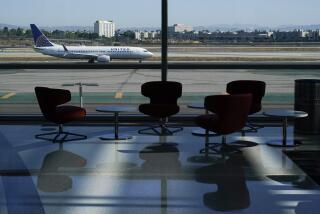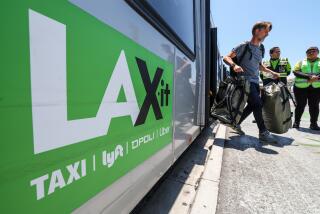LAX Is Slow to Regain Travelers
Los Angeles International Airport is slowly regaining passenger traffic it lost after the Sept. 11 terrorist attacks. But the regional airports that ring Southern California’s hub are regaining passengers more rapidly, as fliers seek out convenience and at least the perception of greater safety.
Many fliers say that, in the wake of the attacks, they can move more quickly and confidently through John Wayne, Ontario and Burbank airports. Shorter lines at ticket counters and security checkpoints are particularly attractive to those who have been caught in long queues at LAX or other large hub airports.
But there were some encouraging signs in figures released Wednesday for Los Angeles’ major international gateway. LAX is enticing travelers back into the skies at a slightly faster pace than some other big-city facilities, such as San Francisco International Airport and John F. Kennedy and La Guardia airports in New York.
Passenger traffic at LAX was down 16.5% in February from the same month last year, according to figures from the city agency that operates the airport. Passenger traffic at the airport was off 18.3% in January and 19.8% in December from year-earlier levels.
LAX’s northern neighbor, San Francisco International, posted a 19.2% decline in traffic in January from the same month a year earlier, and a 24.6% drop in December. At La Guardia and JFK, passenger traffic was down around 20% in December and January. February figures were not available for those facilities.
Even with gradual gains in passengers, prompted in large part by steeply discounted air fares, economists expect air travel to remain depressed for the rest of the year. Air traffic should return to pre-Sept. 11 levels in 2003, according to projections by the Federal Aviation Administration.
While larger airports struggle to return to passenger levels charted before the attacks, smaller facilities are enjoying a newfound popularity among vacationers and businesspeople.
“Smaller airports are indicating to us that they do believe the hassle factor is becoming a benefit for their facilities,” said Scott Foose, vice president of the Regional Airline Assn., a Washington-based trade group.
Jerry Kelly, a biomedical engineer from the Orange County community of Placentia, would certainly concur. Kelly and fellow travelers polled at John Wayne Airport this week said they prefer the Orange County facility over LAX because of its uncrowded terminals, shorter lines and the ability to park in the terminal complex.
“There have been lots of scares and evacuations at LAX. It makes you skittish,” Kelly said. “If terrorists do something, the big airports like LAX or [Chicago’s] O’Hare are probably where they are going to hit.”
John Wayne has recovered virtually all the travelers it lost after Sept. 11. Passenger traffic in February was within 1% of the same month a year earlier.
Regional airport users such as Dallas resident Jerri Ann Massey also say they are willing to pay more to use the smaller facilities. The convenience of flying into Burbank Airport is worth the higher ticket price, said Massey, a manager for Internet provider EarthLink Inc.
Massey, who flies into Southern California about twice a month, preferred LAX before the September terrorist attacks. But with the heightened security and long lines there now, she prefers regional airports, even if it means paying $100 more per ticket.
“It actually saves more, because I spend more time getting work done than standing in lines,” said Massey, 46. “I can leave meetings later in the day.”
Passenger traffic in Burbank was down about 6.7% in February from a year earlier.
Similarly, at Ontario International Airport, operated by the same city agency that runs LAX, passenger traffic levels were down 7.1% in February from a year ago.
Industry watchers say the strength and economic resilience of regional airlines, such as Southwest and upstart JetBlue, have been the most critical factors in attracting customers back.
“The airports doing relatively well have Southwest Airlines,” said Alex Zaslov, senior manger of economic affairs and research at the Airport Operators Council International.
“It has nothing to do with the size of the airport--it seems the trend is based on having a low-cost carrier.”
Indeed, at Long Beach Airport, where JetBlue started service to JFK last summer, passenger traffic climbed 41% in both February and January over year-earlier levels. The carrier expects to increase flights at Long Beach from three to 27 a day in the next year.
This trend has hurt airports like LAX, which suffered huge cutbacks in its flight schedule after Sept. 11, most notably by its largest carrier, United, which slashed its schedule by 40%.
“One of the reasons we’re down to the extent we are is that United cut back so much and they eliminated their Shuttle service,” said Paul Haney, an airport spokesman.
“Southwest stepped up to that by increasing its flight activity at places like Burbank and Ontario.”
LAX was among the U.S. airports hardest hit by the steep downturn in air travel after the hijackings. In the five months following the attacks, LAX lost 22.5% of its commercial operations, according to the FAA.
La Guardia and JFK each posted a 21% loss in commercial operations from September through January, while Reagan National Airport in Washington, which had limited flights after the attacks, posted a 56% downturn, FAA statistics show.
But airlines are slowly adding back service at large hubs like LAX. United and American announced that they will add flights at the facility as summer approaches.
The question remains if travelers will take advantage of these additional flights.
Times staff writers Kristina Sauerwein and Dan Weikel contributed to this report.
More to Read
Sign up for The Wild
We’ll help you find the best places to hike, bike and run, as well as the perfect silent spots for meditation and yoga.
You may occasionally receive promotional content from the Los Angeles Times.






